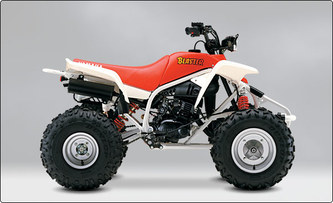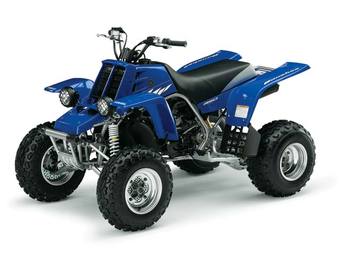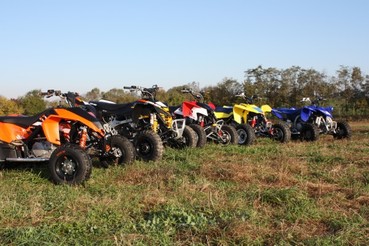|
Originally written for ATV Magazine on February 24, 2010 by Jon Rhodig Preface: This article was written back in 2010 when I wrote for ATV Magazine. The article is a retrospective on machines in the ATV segment that I had direct experiences with comparing market trends and equipment from current (2010) to machines produced up to 20 years ago. Sort of a THEN and NOW comparison and buyers guide. The late 2000's were seeing rapid changes in the ATV market and this article tries to compare and contrast those changes as well as giving my opinion on the ATV's that were part of that time period. This was written before the explosion of side by side machines, at the time there were only a handful of utility based machines. How it came to be... The power sports industry is some what at a cross roads in my opinion. The manufactures are trending to wards more discipline specific machines, following what the motorcycle side of the business has been doing for the last 20 years. Example Yamaha’s YFZ450, you have the “R” model more focused to wards motocross racing and the “X” model that is focused to wards off road/woods racing. The differences are subtle (just like their motorcycle brethren), but enough to make each model more specialized to the needs of that particular discipline. This prompts me to look back at the older models that I have had experiences with and somewhat compare to what we have today. First off in the past an ATV was sort of a generic term for any machine with 4 wheels. The general public barely had a grasp on the concept that there were two different types of machines under the the umbrella term ATV. Of course we as off roaders know these two to be Sport and Utility. Most people associate an ATV with a utility machine with racks and things for hunting or general work, however there are also machines setup for play (more on that below) Also there is the recently added SxS (side by side) market which now has its own division (work vs. play) but that is another topic for another day. Back to the discussion at hand. I am going to look back at my own experiences with machines gone past, give a brief opinion of what I thought at the time as well as opine on if the model would be a good choice for someone looking in the used market. In this economy (2008-2010 sic) the used market is becoming a more prominent area for the new ATV rider as well as the established rider to find their next machine.  MGR rider Derek Hinrichs on the venerable Honda TRX250X MGR rider Derek Hinrichs on the venerable Honda TRX250X 1987 Honda TRX250X Starting off with probably hands down the quad I have had the most experience with. This very ATV (pictured left) has been passed around our group so many times I forget who owned it when. This thing did everything: race, ride, loaner quad, you name it. My impression then: Excellent starter quad, 5 speed manual lets you control the power and when you want to shift just like a racer, but tame power, about 15hp, for the beginning-intermediate skill level. Ride is cushy and can handle moderate jumping. Now: Still an excellent beginner ATV, bullet proof from almost every prospective. Suspension is not all that bad but benefits from at least an upgraded rear shock. This machine holds its value pretty well so as long as you don’t over pay when you buy it you should expect to at least get 80-90% of your money back when you sell.  1987 Suzuki LT250R owned by Chris Flodine 1987 Suzuki LT250R owned by Chris Flodine 1987 Suzuki LT250R This collectible gem can be credited with starting the sport/race ATV segment of the industry. This particular model is the 3rd year of production featuring an updated engine with a power valve and a variation of Suzuki’s first full floater link-aged suspension. My impression then: Wickedly fast on a motocross track. Handles well, jumps straight, feels like a true race machine should. Suspension is plush in the rough stuff but compliant for big g-outs and triple jumps. Now: Still a very collectible machine. A bit underrated and overshadowed by Honda’s TRX250R that was a response to this machine. Engine can be finicky to tune and the power valve on later models are complicated and expensive to replace/repair. Suzuki’s full floater might have been the best idea for a linkage type suspension however it had twice the parts of a conventional rocker arm type thus more parts to grease and wear out. Suspension on used machines are usually thrashed. Parts are not easily crossed between some model years. Wickedly fast and still competitive in the amateur ranks and an all around fun machine to ride. Not for beginners or casual riders.  The Yamaha YFS200 "Blaster" feels like a parts bin machine The Yamaha YFS200 "Blaster" feels like a parts bin machine 1989 Yamaha YFS200 “Blaster” Yamaha’s entry level machine to capitalizing on the ever growing sport market. Not quite a full size machine but not quite a youth machine. My thoughts then: This thing is terrible. Feels like Yamaha went into the parts bin and just grabbed an engine from the Euro/Canadian spec DT200 water cooled engine converted it to air cooling (WTF??), frame, wheels and tires from other motorcycles and ATVs to produce a machine. Engine is peaky and is all top end power. Oil injection that confused owners leading to engine damage because they would forget to refill the oil tank. (see my explanation here sic) Rear shock is mismatched to the frame and swing arm geometry. Rear shock is a linkless design. Suspension is not very adjustable and unfortunately what adjustment there is does not help the lack of damping this thing just bounces around. The rear shock fades after just minutes of riding. The handling is not helped by the heavy balloon type tires on the rear. Now: Almost zero updates in its whole production run. It took until 2002 for hydraulic front brakes to be added (WOW). Previous models have cable operated drum brakes that are almost impossible to adjust so each functions equally, so it pulls left or right on braking. Balloon tires? Really? Need I say more. Find a 2002 and newer machine. Best mods are to add some length to the swing arm, better shocks all the way around. Longer A-arms help stability. Square profile “sport” tires in the rear. Flywheel weight helps power delivery. Know what your buying when buying used as these things get molested by owners searching for fixes to the archaic handling package. This ATV is not for everyone.  Amazing "dune" machine but does little else well Amazing "dune" machine but does little else well 1995 Yamaha YFZ350 “Banshee” The legendary dune machine. Yamaha originally developed this in response to Suzuki and Honda’s 250cc sport machines. Using a variation of a 350cc twin 2 stroke street bike engine (similar to the RZ350) the Banshee lived up to its name. My thoughts then: I only had a brief encounter in a sandy trail area. Blindingly fast in a straight line but suspension felt like it had none. The length helped the straight line stability and off the line launches, but was a major hindrance in the trails. The thing just would not turn without deliberate effort. Motocross track, forget about it, not without some serious modifications to the suspension and engine for better more palatable/usable power delivery. Now: If your into strictly dune riding this is the machine, even in bone stock for this machine will climb, jump and out run most anything (with a good rider) in the sand. Unfortunately this is all the machine does well. Its not a very good trail machine nor a race machine for the track. Extensive modifications can be made to it though to make it handle terrain better but it will cost you. This machine is not for everybody, expect used machines to be molested in some way and plan on tuning it to your liking before you will feel comfortable on it.  Chris Flodine on his Honda 400EX Chris Flodine on his Honda 400EX 2001 Honda TRX400EX The machine that rekindled the sport ATV market in 1999. Honda borrowed its tried and true 400cc engine from the XR400 dirt bike and threw it into a frame reminiscent of the 250R of the past. My thoughts then: Finally a machine that put it all back together again. Similar in nature to the 250X of nearly a decade before it, the 400EX is just a larger package. Plenty of power all around, decent suspension for track or trail with a bit of adjust ability out back, front shocks lack any real adjustment outside of pre-load. Aftermarket is plentiful with BBK’s (big bore kits) and other performance parts to tailor it to the rider. Now: The 400EX started showing its age in about 2005. It has seen no major update since its inception other than a reverse gear in 2006 and different plastic/graphics to make it match the (then) new TRX450R. MSRP’s have steadily risen but performance has stayed at a standstill. Used machines are the best bet here. The ATV as a whole is rock solid reliable. Aftermarket parts are still plentiful. Best mods include, better front shocks, different cam profile, exhaust and a few other ergonomic upgrades. The machine is still a good ATV in stock trim for light entry level racing, but serious racers look elsewhere.  A better attempt but the overall it still doesn't know what it wants to be. A better attempt but the overall it still doesn't know what it wants to be. 2001 Yamaha YFM660R “Raptor” Yamaha’s answer to the question no one asked, “Bigger is better, right?” The Raptor is the first of its kind, a big bore sport quad (excluding the LT500R 2 stroke of the past). Engine borrowed from another one of Yamaha’s motorcycles, the 1984-2003 XT600, a bike not imported to the U.S, bored over to 660cc. My impression then: Loads of torque. The engine is a stump puller nearly identical to the Grizzly (4x4). The whole package is compact if a bit top heavy. This is mostly due to the engine being very tall. Frame, suspension might be a bit under built for how much power the engine puts out. Suspension is a bit stiff out of the box but has enough adjust ability to suit most recreational riders. Not as at home on the track but if lowered a bit it can be made to handle well enough. At home in the trails. Now: The 660 was replaced by the more capable (better frame and suspension) and more well thought out 700R meaning you can only find these used. In my opinion there is no reason to look for a used 660 now that there are used 700′s on the market. The 660 was a half half hearted attempt to progress the big bore sport quad market but really this ATV doesn’t do much well in comparison to other models available on the used market, especially the updated 700R which is what Yamaha should have built in the first place.  This is what the Honda 400EX should have been This is what the Honda 400EX should have been 2004 Suzuki LTZ400 / Kawasaki KFX400 Suzuki’s late to the party entry into the sport market. Engine borrowed from the instant legend DRZ400S off road and dual sport motorcycle. Partnership with Kawasaki to share some parts and technology produced the identical machine under the Kawasaki brand from 2003-2006. My impression then: Wow! this is what the Honda 400EX should have been. Water cooled, modern adjustable shocks, light weight frame, powerful high reving engine. This ATV is happy on the trail as well as the track. Not much modification needed to be a competitive racer even against custom built 250R clones. Aftermarket parts are plentiful to maximize the potential on and off the track. MSRP not much more than the Honda. Now: The Z400 has seen steady updates and refinements over the years and recently adopted EFI. Used Z400′s hold their value fairly well compared to other models. Look for a 2006 and up, those models feature fully adjustable suspension components. Best mod on carburated machines is finding a Keihin 39mm FCR carburetor to replace the anemic CV Mikuni BSR36. The FCR is found standard on early model DRZ400″E” models. Also swapping camshafts from that bike (E model) will move the power up the rev range a tad making this an even more high performing ATV. One of the best all around value machines out there.  Dedicated 450cc race machines didn't make their debut until the late 2000's Dedicated 450cc race machines didn't make their debut until the late 2000's The 450′s…. I have only had brief encounters with the early 450′s, Yamaha’s 2004 YFZ450 (actually only a 440cc engine to comply with the ATVA displacement rules at the time, later models were the full 450cc) and Honda’s 2004 TRX450R (450cc). At the time Honda, as always, bucked the current rule and followed the trend that would become the new displacement rule. Both I thought were amazing at the time, but there was not much to compare to at the time. They both featured good adjustable suspension, lightweight frames, and powerful engines even if they were de-tuned from their motocross bike cousins. Today they are pushing to wards more application specific, motocross and off road setups. More choice is a good thing. The early years were a time when every ATV was a compromise on all around performance to try and make one machine be all things to all people, and as history shows some did it better than others. There you have it my opinions on machines of the past that I have had explicit experiences with. Some may agree and some may disagree. Continue the discussion in the comments section below.
Comments
|
Details
AuthorJon "the junk man" helping to promote responsible riding and recreation whether it be at the track or at the trail. Your source for motorcycle how to videos and much more! Archives
February 2023
|
Proudly powered by Weebly




 RSS Feed
RSS Feed
